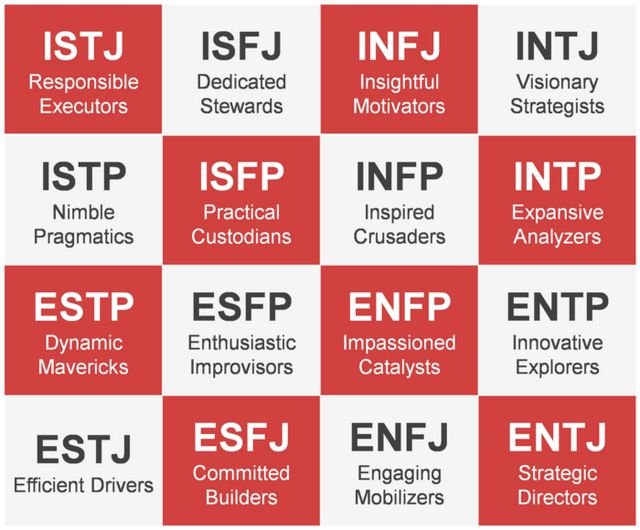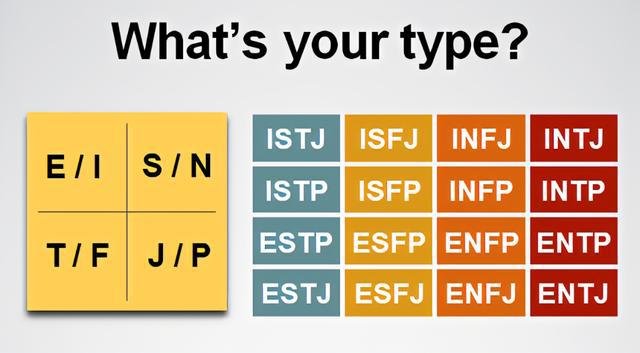
In the complex world of understanding individual behavior and personality traits, the Myers-Briggs Type Indicator (MBTI) is often used as an important tool.
The MBTI provides a framework that allows us to understand people’s innate tendencies and plays an important role in explaining behavior, preferences, and interpersonal relationships.
The MBTI (Myers-Briggs Type Indicator) personality type indicator is a widely used personality assessment tool that measures people’s psychological preferences and behavioral characteristics. It is composed of four pairs of binary opposite traits, forming 16 different personality types. These types are: ISTJ, ISFJ, INFJ, INTJ, ISTP, ISFP, INFP, INTP, ESTP, ESFP, ENFP, ENTP, ESTJ, ESFJ, ENFJ, ENTJ. Here is an overview of these 16 personality types:
- ISTJ – These people are practical, organized, and have a strong sense of responsibility. They are meticulous in taking on responsibilities and are very focused on achieving goals.
- ISFJ – ISFJ type people are friendly, responsible, and committed to the well-being of others. They have a strong sense of service and their decisions are usually based on the impact on others.
- INFJ – These people are intuitive, deep and innovative, and focus on ideals and humanistic values. They are usually very understanding of other people’s feelings and opinions.
- INTJ – These people are usually strategic thinkers, very confident in their ideas, and are good long-term planners.
- ISTP – These people are pragmatic, good at analyzing problems and quickly finding solutions to them. They are usually able to adapt to changes and accept new information.
- ISFP – ISFP people are usually friendly and tolerant. They are keen to enjoy everything in life. They are usually very innovative and can appreciate the beauty of their surroundings.
- INFP – INFP people are idealistic, honest, responsible, and pay great attention to intrinsic values and morals. They are usually very understanding of other people’s emotions.
- INTP – INTP people are innovative, they like theoretical and abstract thinking, and they usually have critical thinking and analytical skills.
- ESTP – These people can adapt quickly to the environment and are good at solving practical problems. They are optimistic and cheerful and enjoy social activities.
- ESFP – ESFP people are peace-loving. They are usually warm, friendly and helpful. They enjoy building relationships with people and are able to appreciate the beauty of life.
- ENFP – These people are passionate and innovative, and usually have strong values and enthusiasm for the future.
- ENTP – These people are innovative and smart, they are good at theoretical thinking, good at reasoning, and like new ideas, new information and new perspectives.
- ESTJ – These people are serious, organized and practical, they are usually good leaders, they are good at making decisions and firmly implementing them.
- ESFJ – These people are friendly and responsible, they pay great attention to the feelings and needs of others, and they attach great importance to the values of peace, security and tradition.
- ENFJ – These people are usually passionate and responsible, they can understand and appreciate the needs and feelings of others, and they have the ability to inspire the potential of others.
- ENTJ – These people are true leaders, they are organized and can see the overall situation of the problem, they are decision makers, and they usually have a clear understanding of the external environment.

In personality psychology, Myers-Briggs Type Indicator (MBTI) is a widely used tool that helps us understand the differences in people’s personalities and tap the potential of each person.
MBTI describes personality types through four dimensions: Extraversion (E) vs Introversion (I), Sensing (S) vs Intuition (N), Thinking (T) vs Feeling (F), Judging (J) vs Perceiving (P). These four opposing dimensions form 16 different personality types.
- Extraversion (E) vs Introversion (I): This dimension involves the way individuals get energy. Extroverts get energy from interpersonal communication. They are good at communication and like teamwork. Introverts get energy from solitude and reflection. They are more independent and like deep thinking.
- Sensing (S) vs Intuition (N): This dimension involves the way of information processing. Sensing people focus on reality and concrete things. They pay attention to details and seek truth from facts. Intuitive people focus on abstract and potential meanings. They like to explore possibilities and are good at innovation.
- Thinking (T) vs Feeling (F): This dimension involves decision-making preferences. Thinking people tend to logical analysis and objective standards. They are fair and rigorous in thinking. Feeling people pay more attention to interpersonal relationships and values. They are compassionate, good at understanding and caring for others.
- Judging (J) vs. Perceiving (P): This dimension involves attitude towards life. Judging people like planning and order. They can stick to their goals and be organized. Perceiving people tend to be flexible and open-minded. They are willing to adapt and like to explore.
Through the above four dimensions, MBTI depicts the differences in people’s personalities. However, it should be noted that these types are not fixed, but tendencies within a certain range. Similarly, people’s personalities are not determined by a single dimension. The types divided by MBTI are just a reflection of the diversity of people’s personalities.
Understanding the characteristics of these personality types can help us understand our own behavior patterns and how we process information, make decisions and interact with others. And understanding other people’s personality types can help us understand their behavior and improve our interpersonal relationships and teamwork.